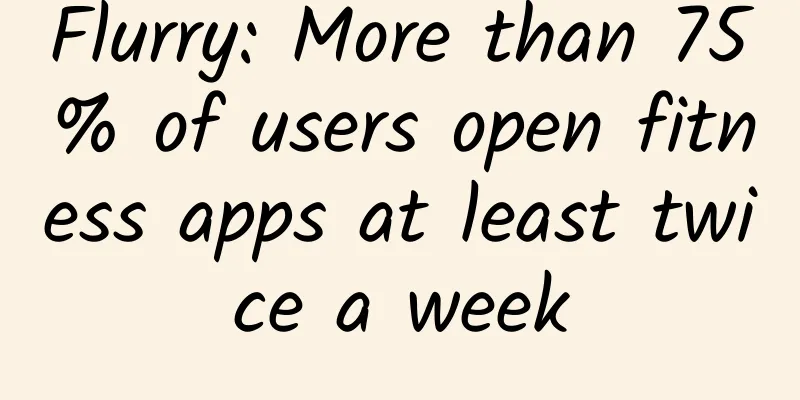Flurry: More than 75% of users open fitness apps at least twice a week

|
199IT original compilation According to Flurry, 96% of active fitness app users only use one fitness app. As shown in the App Loyalty Matrix, health and fitness apps show the highest retention rate among all categories. This shows that once users start using a fitness app, they stay dedicated. More than 75% of active users open health and fitness apps at least twice a week. Moreover, the percentage of health app addicts is very high: more than 25% of users visit fitness apps more than 10 times a week. Therefore, this frequency of use drives engagement in the overall category. This is an attractive opportunity for app developers to leverage frequent user engagement to monetize. Year-on-year growth slowed Health and fitness apps have grown significantly since 2014. In just three years, usage has increased by more than 330%. However, since 2016, growth has slowed: from 2014 to 2015, usage increased by 178% year-over-year; however, from 2016 to 2017, health and fitness app usage grew by only 9%, in line with the overall app industry. The largest subcategory, exercise and weight loss apps, grew significantly slower than the previous year, dropping from 67% in 2015 to 11% in 2016. Another major subcategory, general health tracking, has shown stagnation over the past two years. Nutrition apps saw a decline in usage over the last year, but studio and fitness content apps still grew 49%. Track, Set, Move: Exercise and Weight Loss Apps Exercise and weight loss apps accounted for 73% of all health and fitness app sessions. Although general health apps still accounted for 41% of the market share in 2014, they are increasingly being eroded by exercise and weight loss apps. Wearable devices such as smart bands and smart watches are an important driver of their growth. Fitness Studios and Health Clubs with Apps Studio and fitness content apps are growing rapidly: more than 830% since 2014. Fitness app use is associated with seasonal exercise habits Fitness app usage drops significantly in the last few months of the year and during the holidays. December 25th is the lowest usage day, 57% less than August 8th. From a weekly perspective, users are more active in fitness apps from Monday to Wednesday, but usage drops significantly on weekends. Saturday usage is 10% lower than the average. Flurry data shows that the use of health and fitness apps peaks in the morning and evening. The busiest times for gyms are between 9 and 11 a.m. and between 5 and 8 p.m. However, the peak usage of fitness apps is around 10 p.m. 199IT.com Originally compiled from: Flurry. Please do not reprint without authorization |
<<: eMarketer: 60% of US mobile phone users frequently use mobile search in 2017
>>: What does "take three and stop four" mean for azithromycin?
Recommend
When will the sixth season of Informal Talks start? What are the guest lineups for the sixth season of Informal Talks?
The sixth season of The Informal Talks is about t...
What soup is good to drink during menstruation?
Women should keep warm during menstruation and ea...
I have leucorrhea every day and my period hasn't come yet.
Problems with menstruation and abnormal leucorrhe...
What is the white color inside the vagina?
Many women will experience vaginal itching, and s...
What are the benefits of moxibustion during the 90 days of winter?
The 39 days are the coldest time of the year. &qu...
A little bleeding during pregnancy
If you have a little vaginal bleeding during preg...
Can I drink rice wine during menstruation?
Rice wine is a favorite choice of many people. Wh...
Which is more accurate, vaginal ultrasound or abdominal color Doppler ultrasound?
Vaginal ultrasound and abdominal color ultrasound...
How to use Chinese medicine to regulate scanty menstruation?
Every woman has a few special days every month. W...
Why does my breast hurt when I touch it?
Among female organs, breasts have very important ...
Treatment of hematuria in women with urethritis
Urethritis is an inflammatory disease. The main f...
Why is my period not clean for more than ten days?
Although most women in the workplace have menstru...
What are the health products for menopausal women?
As many women get older, especially after menopau...
What to do if you have a tilted pelvis
There are two big bones on both sides of the pelv...
Is delayed menstruation and backache a sign of pregnancy?
When women reach a certain age, they will have th...









